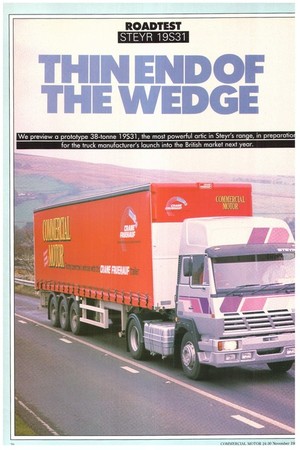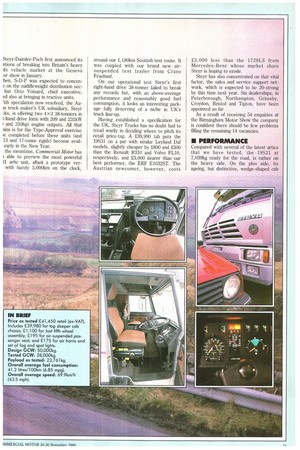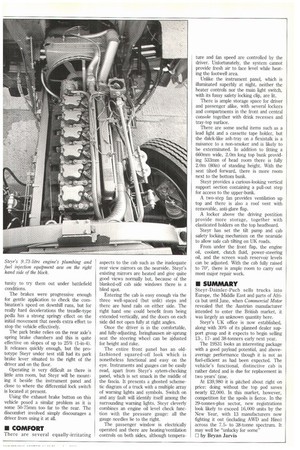THIN ENDOF THE WEDGE
Page 44

Page 45

Page 46

Page 47

If you've noticed an error in this article please click here to report it so we can fix it.
Steyr-Daimler-Puch first announced its ntions of breaking into Britain's heavy ds vehicle market at the Geneva or show in January.
hen, S-D-P was expected to concenP. on the middleweight distribution secbut Otto Voisard, chief executive, ed also at bringing in tractive units.
rith speculation now resolved, the Ault' truck maker's UK subsidiary, Steyr is offering two 4x2 38-tonners in t-hand drive form with 209 and 231kW I and 310hp) engine outputs. All that ains is for the Type-Approval exercise )e completed before these units (and 13 and 17-tonne tigids) become availearly in the New Year.
the meantime, Commercial Motor has able to preview the most powerful U artic unit, albeit a prototype verwith barely 5,000km on the clock,
around our 1,180km Scottish test route. It was coupled with our brand new airsuspended test trailer from Crane Fruehauf.
On our operational test Steyr's first right-hand drive 38-tonner failed to break any records but, with an above-average performance and reasonably good fuel consumption, it looks an interesting package fully deserving of a niche in UK's truck line-up.
Having established a specification for the UK, Steyr Trucks has no doubt had to tread warily in deciding where to pitch its retail price-tag. A 239,990 tab puts the 19531 on a par with similar Leyland Daf models, slightly cheaper by 2800 and 2500 than the Renault R310 and Volvo FL10, respectively, and 23,000 dearer than our best performer, the ERF E1032ST. The Austrian newcomer, however, costs 23,000 less than the 1729LS from Mercedes-Benz whose market share Steyr is hoping to erode.
Steyr has also concentrated on that vital factor, the sales and service support network, which is expected to be 20-strong by this time next year. Six dealerships, in Peterborough, Northampton, Grimsby, Croydon, Bristol and Tipton, have been appointed so far As a result of receiving 54 enquiries at the Birmingham Motor Show the company is confident there should be few problems filling the remaining 14 vacancies.
• PERFORMANCE
Compared with several of the latest artics that we have tested, the 19S31 at 7,039kg ready for the road, is rather on the heavy side. On the plus side, its ageing, but distinctive, wedge-shaped cab has the benefit of a top-sleeper pod while Steyr also favours the long-haul operators with a larger capacity (and thus heavier) 550-litre fuel tank.
Fully laden to the UK maximum 38tonne limit, the Steyr returned 41.2 litres/ 100km (6.85mpg) at an overall average speed of 69.9km/h (43.5mph).
The artic's journey times fall just short of the ERF E10-325 (CM 2 June 1988) which is the best all-rounder in its class, but its fuel consumption disappointed even the accompanying engineer from Austria who, until then, must have believed that Britain was as flat as Holland.
Compared with Austria, it may well seem so, but he was totally unprepared for the severe A68 section across Northumberland which took its toll in derv.
It also exposed the 9.7-litre engine's sharp drop-off in output at around 1,300rpm which required early downchanges on the worst of the climbs.
Consumption rose to over 50 litres/ 100km (less than 5.0mpg) around this short 85Iun section and, but for the Twin Splitter's ability to allow very speedy gear change both up and down the box, the Steyr would have struggled even more.
Around the remainder of the route, its consumption was fairly middling but some way below that expected by Steyr Trucks, especially as the weather was kinder than it had been the previous month during the Scania 143 and Volvo FL10-320 roadtests.
Steyr might have been better advised to put at least 25,000km on the 19531 before submitting it to such a searching appraisal as ours because the relative newness of the engine makes it difficult to assess its optimum performance. It is certainly not seen in its best light.
• DRIVELINE
Like many of its competitors. Steyr manufactures its own engines, including the 225kW WD 615,68 in the 19531.
At 126x130mm stroke its 9.73-litre diesel is shorter than the 9.6-litre Volvo TD102F's 121x140mm and the 125x 136inm of the Cummins LTAAIO, but with air-to-air charge-cooling the Steyr unit churns out a creditable 1,250Nm (9221bft) at 1,300rpm to EEC 80/1269 ratings.
As well as having a sharp 30% torque rise, the 19531 engine's theoretical performance graph shows that it is at its lowest 197g/kWhr point at 1,500rpm and remains below 200g/kWhr between 1,300 and 1,700rpm.
For the UK market, Steyr has turned away from the Continental preference for synchromesh gearboxes in favour of Eaton's Twin Splitter but offers the ZF Ecosplit as an option for an extra £445.
With the Twin Splitter's 1.25:1 intermediate fourth (11th) and direct top gear, 3.73:1 final drive in the Rockwell U180E axle and using 295/80R 22.5 radials, the 19531 cruises comfortably at the 64, 80 and 96km/h (40, 50 and 60mph) speed limits.
Across this speed range, where the engine revs hover between 1,550 and 1,850rpm, there is never less than 1,100Nm of torque available.
Over flat and gently-rolling terrain, the 19531 lived up to expectations in spite of strong headwinds on the Al, Al(M) and M18 on day three which spoiled its fuel return. Even so the artic failed to cash in on the first day's tail winds along the A5 and M6.
As we had not used a Twin Splitter for some time, it took a little while to regain the level of dexterity needed to ensure the fastest possible gearchanges through the 12 ratios of the single-H arrangement.
Nevertheless, using second, fifth and seventh, followed by successive gears seemed the likeliest choice of sequence and this can be varied to suit the lie of the land. The clutch pedal is lightly loaded for the odd occasions when it is used.
The 19S31's acceleration times from 064km/h of 44.7 seconds is two seconds behind the Volvo FL10, a few more adrift of the ERF E10-32ST, though five ahead of the Mercedes 1729LS with its electropneumatic EPS gear shifting. Renault's R310, with its 18-speed synchromesh unit, is also five seconds slower than the Steyr.
Over the hill climbs, the 19S31's times are comparable with those vehicles which we have tested but on the severest Blackhill climb, its extra minute over the ERF was due largely to having to anticipate the engine's early lack of bite at around the 1,300rpm mark.
• HANDLING
The Steyr 19531 handles surprisingly well with the long 1,898mm front and 1,906mm rear four-leaf parabolic road springs giving a very firm ride, particularly over poor surfaces.
Anti-roll bars, fitted as standard front and rear, helped to keep lateral roll to a minimum on twisty roads.
Steyr will be offering air suspension on the rear as an optional extra which adds another £1,750 to the retail price. An air dump feature for easy uncoupling of semitrailer is included.
Steyr Trucks has added to the British appeal by adopting the Cameri, Italianbuilt Rockwell drive axle to go with the Austrian-made steering axle.
The fact that each uses its own S-cam brakes complicates matters from a service viewpoint, but both are self-adjusting.
Damp tracks prevented our usual Motometer tests but with busier traffic than usual and a dozen or so roadworks sections to negotiate there was ample oppor tunity to try them out under battlefield conditions.
The brakes were progressive enough for gentle application to check the combination's speed on downhill runs, but for really hard decelerations the treadle-type pedla has a strong springy effect on the initial movement that needs extra effort to stop the vehicle effectively.
The park brake relies on the rear axle's spring brake chambers and this is quite effective on slopes of up to 25% (1-in-4). It releases quickly enough, but the prototype Steyr under test still had its park brake lever situated to the right of the driver and on the floor.
Operating is very difficult as there is little arm room, but Steyr will be mounting it beside the instrument panel and close to where the differential lock switch is located at present.
Using the exhaust brake button on this vehicle posed a similar problem as it is some 50-75mm too far to the rear. The discomfort involved simply discourages a driver from using it at all.
• COMFORT
Mr! c are several equally-irritating aspects to the cab such as the inadequate rear view mirrors on the nearside. Steyr's existing mirrors are heated and give quite good views normally but, because of the blanked-off cab side windows there is a blind spot.
Entering the cab is easy enough via the three well-spaced (but unlit) steps and there are hand rails on either side. The right hand one could benefit from being extended vertically, and the doors on each side did not open fully at right angles.
Once the driver is in the comfortable, and fully-adjusting, Isringhausen air-sprung seat the steering wheel can be ajdusted for height and rake.
The entire front panel has an oldfashioned squared-off look which is nonetheless functional and easy on the eye. Instruments and guages can be easily read, apart from Steyr's sytem-checking panel, which is set smack in the middle of the fascia. It presents a ghosted schemetic diagram of a truck with a multiple array of warning lights and symbols. Switch on and any fault will identify itself among the surrounding warning lights. Steyr cleverly combines an engine oil level check function with the pressure gauge: all the gauge needles lie to the right.
The passenger window is electrically operated and there are heating/ventilation controls on both sides, although tempera
ture and fan speed are controlled by the driver. Unfortunately, the system cannot provide fresh air to face level while heating the footwell area.
Unlike the instrument panel, which is illuminated superbly at night, neither the heater controls nor the main light switch, with its fussy safety locking clip, are lit.
There is ample storage space for driver and passenger alike, with several lockers and compartments in the front and central console together with drink recesses and tray-top surface.
There are some useful items such as a lead light and a cassette tape holder, but the dalek-like ash-tray on a flexistalk is a nuisance to a non-smoker and is likely to be exterminated. In addition to fitting a 660mm wide, 2.0m long top bunk providing 533mm of head room there is fully 2.0m (80in) of standing height. With the seat tilted forward, there is more room next to the bottom bunk.
Steyr provides a curious-looking vertical support section containing a pull-out step for access to the upper-bunk.
A two-step fan provides ventilation up top and there is also a roof vent with removable, anti-glare flap.
A locker above the driving postition provide more storage, together with elasticated holders on the top headboard.
'Steyr has set the tilt pump and cab safety locking mechanism on the nearside to allow safe cab tilting on UK roads.
From under the front flap, the engine oil, coolant, clutch fluid, power-steering oil, and the screen wash reservoir levels can be adjusted. With the cab fully raised to 700, there is ample room to carry out most major repair work.
• SUMMARY
Steyr-Daimler-Puch sells trucks into Europe, the Middle East and parts of Africa but until June, when Commercial Motor revealed that the Austrian manufacturer intended to enter the British market, it was largely an unknown quantity here.
Steyr's UK office is now established, along with 30% of its planned dealer support group and it expects to begin selling 13-, 17and 38-tonners early next year.
The 19S31 looks an interesting package with a good payload potential, and aboveaverage performance though it is not as fuel-efficient as had been expected. The vehicle's functional, distinctive cab is rather dated and is due for replacement in two years' time.
At £39,980 it is pitched about tight on price: doing without the top pod saves nearly £2,000. In this market, however, competition for the spoils is fierce. In the 29-tonnes-plus sector, new registrations look likely to exceed 16,000 units by the New Year, with 13 manufacturers now fighting it out (including AWD and Hino) across the 7.5to 38-tonne spectrum. It may well be "unlucky for some"
0 by Bryan Jarvis










































































































